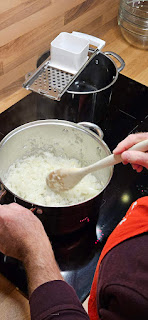Our last full day in Budapest was a perfect mix of relaxation, discovery, and hands-on learning. While there were still so many things we didn’t get to see or do, we made the most of our time by soaking in Budapest’s famous Széchenyi Thermal Bath in the morning and diving into Hungarian culinary traditions in the afternoon with a market tour and cooking class.
As the sun set on our journey, we reflected on everything Budapest had to offer—its rich history, vibrant markets, unique traditions, and unforgettable flavors.
Morning: Széchenyi Thermal Bath
Budapest is famous for its thermal baths, and we couldn’t leave the city without experiencing one for ourselves. We spent the morning at the Széchenyi Thermal Bath, the largest and most iconic thermal bath in Budapest.
The Thermal Waters of Budapest
The city sits on a network of geothermal springs, providing natural hot water to its many baths. Beneath Budapest, over 100 thermal springs produce millions of gallons of mineral-rich water daily. These springs have been used for bathing and healing since Roman times, and their popularity continued through the Turkish occupation when hammams were built.
At Széchenyi, the water is supplied by two thermal springs, with temperatures ranging from 74°F to 104°F (23°C to 40°C). The waters are said to be rich in minerals like calcium, magnesium, and sulfate, making them therapeutic for joint pain and other ailments.
History and Architecture of Széchenyi
Built in 1913, the Széchenyi Bath was one of the first large-scale thermal baths on the Pest side of the city. Its Neo-Baroque architecture makes it as beautiful as it is functional, with grand yellow facades, domed roofs, and intricate mosaics.
The bath complex includes 15 indoor pools and three outdoor pools, with a variety of temperatures and experiences. The outdoor pools are especially famous—steaming in the cold winter air, surrounded by stunning architecture. It’s not uncommon to see locals playing chess on floating boards while enjoying the warm water!
Our visit was the perfect way to unwind and soak in this quintessential Budapest experience.
Afternoon: Hungarian Cooking Class and Market Tour
In the afternoon, we joined a Viator tour called "Hungarian Cooking Class in Budapest - Foodapest", a foodie adventure that combined a guided market tour and hands-on cooking experience.
Touring the Central Market Hall
We started at the Budapest Central Market Hall, a stunning indoor market that’s both a culinary hub and a cultural landmark. Our guide gave us an insightful tour, pointing out authentic Hungarian foods and sharing the history behind them:
- Hungarian Pork: The country is known for its high-quality pork, particularly Mangalica, a heritage breed prized for its marbled meat.
- Sausages: In the days before refrigeration, sausages were essential for preserving meat, and they remain a staple of Hungarian cuisine. We saw everything from spicy paprika sausages to smoked kolbász.
- Pickled Foods: Hungarians love their pickles! From cucumbers to cabbage, pickling is a beloved method of preserving vegetables, especially during winter.
- Hungarian Wines: The guide described the distinct wine regions of Hungary, like Tokaj, famous for its sweet dessert wines, and Eger, known for its robust reds.
 |
| Our guide and cook (next to the Chicken Man statue) |
 |
| Hungarian pigs are a mix breed that feed off of acorns |
 |
| A sampler plate of pickled vegetables |
Cooking at the Food Workshop
After gathering ingredients at the market, we headed to a nearby workshop kitchen to start our cooking class.

Appetizers
We began with Hungarian sausages, cheese, and a local white wine. It was a delicious way to set the mood for cooking and to learn more about traditional Hungarian flavors.
Cooking Chicken Paprikash
The star of our meal was Chicken Paprikash, a classic Hungarian dish. Here’s how we prepared it:
- Chopping Vegetables: We diced onions, Hungarian peppers, and tomatoes, all staples in Hungarian cooking.
- Sautéing: We sautéed the onions in oil until they were soft and golden, then added the peppers and tomatoes.
3. Prepping the Chicken
4. Making the Roux: We created a rich paprika-spiced roux, which gives the dish its signature flavor and color.
5. Cooking the Chicken: The chicken was simmered in the paprika sauce until tender.
Making Nokedli
To accompany the paprikash, we made Nokedli (Hungarian spaetzle). Rolling up our sleeves, we mixed the dough and used a special tool to press it into boiling water. These little dumplings turned out perfectly!

Dinner Time
When everything was ready, we sat down to enjoy our meal. The creamy chicken paprikash paired with the soft nokedli was comforting and full of flavor—a true taste of Hungary.
Evening: A Bittersweet Farewell
After thanking our guide for an incredible experience, we made a quick stop at a nearby grocery store to pick up a few Hungarian treats to pack in our suitcase. Then, we hopped on the #72 bus for one final ride back to the Mystery Hotel, where we spent the evening packing and reflecting on our time in Budapest.
Reflections on the Day
From soaking in the healing waters of Széchenyi to learning how to cook Hungarian classics, today was the perfect mix of relaxation and adventure. Budapest has left a lasting impression on us, and we’ll carry these memories—and recipes—home with us.
This blog post was created collaboratively with the assistance of ChatGPT, an AI language model by OpenAI, to help structure and document our journey.























































.jpg)











